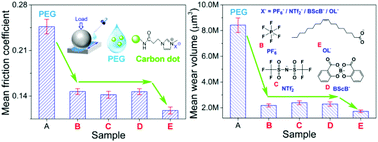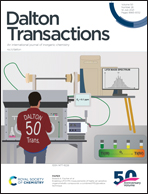Tribological properties of a series of carbon dots modified by ionic liquids with various anion species: experimental findings and density functional theory calculations†
Abstract
A series of carbon dots modified by ionic liquids with various anion species (CDs-ILs-X) were facilely synthesized by a one-pot pyrolysis method and subsequent anion exchange processes, where X− represented the anions of hexafluorophosphate (PF6−), bis(trifluorosulfonyl) imide (NTf2−), bis(salicylato) borate (BScB−) and oleate (OL−). Their tribological properties as lubricant additives of polyethylene glycol (PEG200) were investigated under the ball-on-plate reciprocating mode and steel/steel contact. The maximum friction coefficient and wear volume reductions of PEG200 triggered by CDs-ILs-PF6, CDs-ILs-NTf2, CDs-ILs-BScB and CDs-ILs-OL were up to 42.5% and 71.8%, 40.5% and 74.0%, 40.5% and 72.8%, and 52.2% and 79.5%, respectively. The excellent friction-reducing and anti-wear properties of CDs-ILs-X could be attributed to the formed boundary lubrication films composed of tribochemical products and CDs on the rubbing surfaces. The density functional theory calculations well explained the specific effects of anion species on the tribological performances of CDs-ILs-X. The strongest absorption stability and lowest steric hindrance of OL− made the CDs-ILs-OL form the densest boundary lubrication films on the sliding interfaces, and hence the CDs-ILs-OL exhibited the best tribological performance. The CDs-ILs-OL are promising lubricant additives to PEG owing to their high-performance, low cost and environmental friendliness.



 Please wait while we load your content...
Please wait while we load your content...